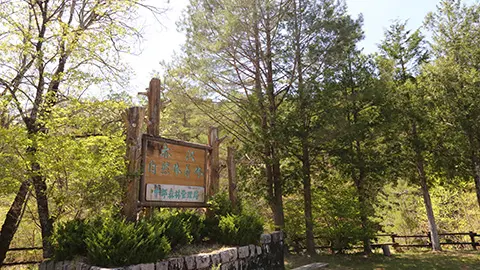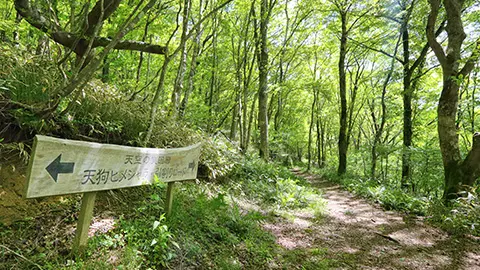VOL.192 MAY 2024
JAPAN’S HEALING FORESTS (PART 1)
Exploring ‘Kumano Kodo,’ a Forest-Enveloped World Cultural Heritage Site

A pilgrimage route leading to three sacred sites known as Kumano Sanzan. The model in the photograph is wearing attire typical of upper-class ladies during the medieval period, often worn while traveling.

A mountain forest along the Kumano Kodo, which includes numerous subsidiary shrines called “Oji,” meaning “prince,” dedicated to the divine offspring of Kumano Sanzan.
Photo: Kumano Hongu Heritage Center
The Kii Peninsula, Japan’s largest, lies slightly west from the central area of Honshu, extending into the Pacific Ocean. Within the Kii Peninsula, trails known as the ‘Kumano Kodo’ have been preserved since ancient times. A section of these routes has been designated as a UNESCO World Cultural Heritage Site,* making it one of the rare trails worldwide to receive such recognition. This year, 2024, marks the 20th anniversary of the listing of the ‘Sacred Sites and Pilgrimage Routes in the Kii Mountain Range,’ which includes the Kumano Kodo routes. Here, we take a look at Kumano Kodo, situated amid the forests of the Kii Mountains.
The majority of the Kii Peninsula is occupied by mountainous terrain, known as the Kii Mountain Range, which spans the three prefectures of Mie, Nara, and Wakayama. The mountain range with elevations ranging from 1,000 to 2,000 meters runs from East to West and from North to South and is characterized by a warm and extremely rainy climate, nurturing rich forests over the years.
To the southeast lies a sacred site known as ‘Kumano Sanzan,’ primarily comprising three shrines and two temples. This site has been a center of faith for centuries and is recognized as a vital component of the World Cultural Heritage Site. Near one of the three grand shrines, Kumano Hongu Taisha (located in Tanabe City, Wakayama Prefecture), sits the Kumano Hongu Heritage Center, dedicated to the dissemination of tourist information and local information. We spoke with Sugawa Aki who works at the center.
“The region centered around Kumano Sanzan, enveloped by the natural beauty of the Kii Mountain Range and known as ‘Kumano,’ has been revered as a sacred place dedicated to the gods since ancient times. Furthermore, from the 10th to the 11th century onwards, former emperors and monk emperors as well as nobles, frequently visited this sacred area on journeys known as Kumano pilgrimages. I believe that’s why the trails were so well maintained,” explains Sugawa.
“Kumano Kodo is a collective term referring to both Kumano Sanzan, consisting of three shrines—Kumano Hongu Taisha, Kumano Hayatama Taisha, and Kumano Nachi Taisha—and two temples,** as well as the ancient roads connecting them with Ise, Osaka, Wakayama, Mount Koya, and Mount Yoshino.*** It is said that all the pilgrimage routes of the Kii Peninsula stretch over 1,000 kilometers, with a particularly culturally valuable section of it registered as a World Cultural Heritage Site, measuring approximately 350 kilometers.”
Kumano Kodo is a network of pilgrimage routes connecting sacred sites such as Ise Jingu (‘Ise Grand Shrine’)**** and Kumano Sanzan. It comprises approximately seven routes, including Kohechi, Nakahechi, and Ohechi. Of these, Kohechi linking Mount Koya and Kumano Sanzan, and Nakahechi, the primary pilgrimage path to Kumano Sanzan as well as linking the shrines and temples of Kumano Sanzan itself, are particularly recommended for those who wish to enjoy forest scenery.
“The Nakahechi route is characterized by numerous plantations of cedar and cypress trees,” says Sugawa. “These man-made forests are well-maintained through practices such as thinning, allowing people to walk through beautiful, well-tended groves. Due to the high rainfall all year round, there is also an abundance of rare fern species.”
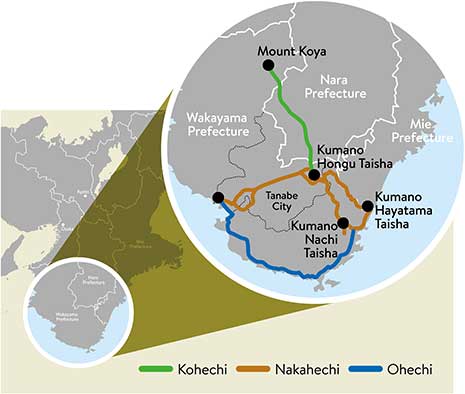

The Nakahechi route is a mountain route that stretches from present-day Tanabe City in Wakayama Prefecture to Hongu, Shingu, and Nachi.
Photo: Kumano Hongu Heritage Center
Sugawa says that walking through the forests from early summer to summer offers an exceptional experience. “The forests along Kumano Kodo are relatively cool, and the amount of UV is only one-fiftieth of that in open sunny areas, so you can walk safely even in summer. In early summer, the forests are filled with new sprouts of ferns and other plants, as well as various flowers, offering plenty of sights to enjoy.”
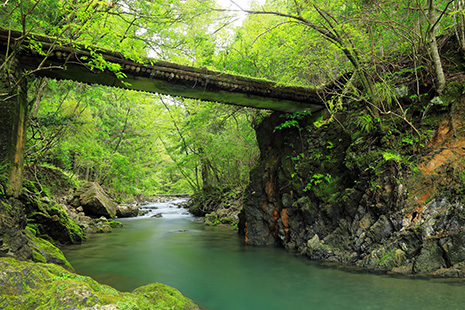
The view around Kumano Kodo’s Doyu River
Photo: Kumano Hongu Heritage Center
The forest bed made from thinned wood that Sugawa recommends along a section of the Nakahechi route from Hosshinmon Oji to Kumano Hongu Taisha is perfect for relaxing.
“If you lie down, you can feel the essence of the Kumano forests in the silence,” comments Sugawa.
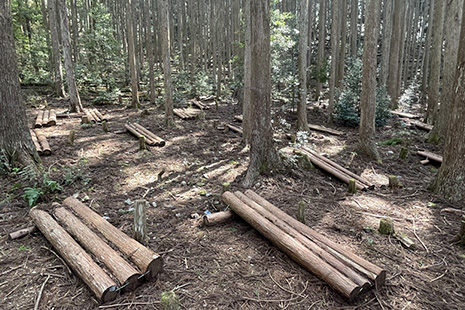
Forest bed made from thinned wood
Photo: Kumano Hongu Heritage Center
The most popular route among overseas visitors is the approximately 38 km Nakahechi Route from Takijiri-oji to Kumano Hongu Taisha, which is easy to walk. Sugawa explains, “It is best enjoyed over one night and two days or two nights and three days, allowing for a leisurely journey. Takijiri-oji is considered the gateway to the sacred area of Kumano Sanzan, and from here, you enter a truly mountainous path.”
She continues, “The forest scenery is spectacular, and the route occasionally passes through mountain villages, offering a glimpse of traditional Japanese landscapes, making it popular among overseas visitors. I recommend trying it when you visit Kumano. This year marks the 20th anniversary of the listing of Kumano Kodo pilgrimage routes as part of the UNESCO World Cultural Heritage Site, and numerous events are planned to celebrate. We hope to welcome as many visitors as possible.”

A glimpse of the scenery along the way from Takijiri-oji to Kumano Hongu Taisha on the Nakahechi route
Photo: Kumano Hongu Heritage Center
* The only two pilgrimage routes to be granted UNESCO World Cultural Heritage status are the ‘Sacred Sites and Pilgrimage Routes in the Kii Mountain Range’ in Japan and the Santiago de Compostela in Spain and France, as of now.
** In addition to the three shrines, it also refers to two Buddhist temples near Kumano Nachi Taisha, namely Seiganto-ji Temple and Fudarakusan-ji Temple.
*** Mount Yoshino is part of the World Cultural Heritage ‘Sacred Sites and Pilgrimage Routes in the Kii Mountain Range.’ Similarly, Mount Koya includes Kongobuji Temple, whch is also integral to the designation.
**** A shrine located in Ise City, Mie Prefecture, Japan, officially called ‘Jingu.’ It includes the Inner Shrine (Naiku), which enshrines the Sun Goddess Amaterasu Omikami, and the Outer Shrine (Geku), which enshrines Toyouke Omikami, the deity and guardian of industry, including food, housing, and clothing. In total, there are 125 shrines, including 14 auxiliary shrines. These are collectively referred to as ‘Jingu.’
By Morohashi Kumiko
Photo: Kumano Hongu Heritage Center; PIXTA
